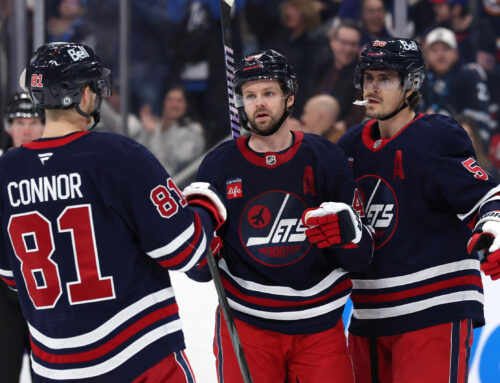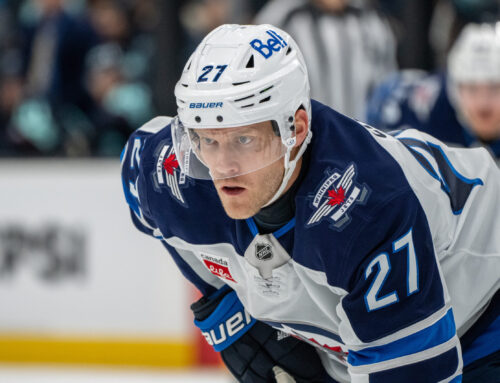The Fantasy Value of the Defensive Specialist
Doran Libin
2016-03-14

Libin takes a look at the fantasy value of the defensive specialist…
Marcus Kruger recently signed a three-year deal worth just north of nine million. The deal received mixed reviews based Kruger’s age and the numbers he puts up. From a number’s stand point Kruger does not bring much to the table but he is not asked to put up big numbers by the Blackhawks. Kruger is asked to fill a specific role for the Blackhawks, he gets the majority of the defensive zone starts and is asked to push the puck up the ice while doing so. Kruger starts just 12% of his shifts in the offensive zone, which is good for the lowest percentage of offensive zone starts outside of Nashville. Even facing such a tilted ice surface Kruger until this year the Blackwawks have routinely managed to generate at least 50% of the shot attempts whit him on the ice. This year has been a struggle for Kruger as his on-ice shooting percentage has fallen through floor. The combination of the way he is used and a rough year have Kruger’s numbers even lower than they usually are. While this year has been a struggle Kruger has never been a major scoring threat with a career high in points of 20. He also provides limited peripheral value as he does not take penalties, get blocks or dole out the hits. Other than taking, and winning, his share of face-offs there really is not much of a reason to have Marcus Kruger on a fantasy hockey team. That does not however mean that he is without fantasy hockey relevance. Kruger’s relevance is not based is his own numbers but rather in what he allows his teammates to do.
Players like Marcus Kruger who get buried under extreme offensive allow for other players to take on much more offense-centric roles. In Chicago the main beneficiary is Patrick Kane and his linemates who get extreme offensive zone starts. In Nashville Paul Gaustad faces even more extreme defensive zone starts, only getting five percent of his zone starts in the offensive zone, so that Mike Ribeiro and his linemates can play a much more offensive role. Ribeiro in fact is perhaprs the biggest beneficiary of having a defensive specialist playing behind him as his line gets close to 80% offensive zone starts. Dallas has two sets of extremes to varying degrees. Radek Faksa, when he has played has been buried in the defensive zone starts, and Vern Fiddler has been used in a similar capacity. That leaves the more offensive zone starts for the Spezza and Seguin lines as both start more than 55% of their shifts in the offensive zone. The alternative is a zone start distribution that is more akin to that of the Los Angeles Kings where the each line has pretty similar zone start percentages.
Strong two-way players do not get the same benefits from the extreme defensive zone starts of the defensive specialists that more one-dimensional offensive players receive. Take Jonathan Toews as an example, in that he still gets fairly average offensive zone starts given Chicago’s strong possession game because he is expected to take on some of the burden of the tougher defensive minutes. The same was true of the 2010-11 Canucks and Ryan Kesler, and can also be seen this year in Anaheim. There Kesler has the extreme defensive zone starts, Getzlaf is in the middle and the Perry gets the benefit of playing downhill as a result. Thus while they get a bit of a break and start fewer times in the defensive zone than they would otherwise the impact is not nearly as large as potentially could be if he was less responsible defensively.
Such extreme usages allow somewhat one-dimensional players to be placed in situations where that favour the dimension of their game in which they are dominant. It can make elite offensive talents all the productive as they focus even more on the offensive side of their game. For example the Sedins best years came when Manny Malhotra was buried under extreme defensive zone starts and Ryan Kesler was there to take the middle ground thus putting the Sedins in the best possible situation to produce offensively. The best facsimile of that situation this year is the Blackhawks where Kane and Panarin in the role of the Sedins, Toews in the Kesler role and Kruger in the Malhotra role. It should be no surprise that Kane is having a career year given how well Panarin has adjusted to the NHL. Where Kane is helped additionally is Kruger’s unique ability to drive possession despite being buried under heady defensive zone starts. Looking at Malhotra and Gaustad, two of the netter examples of players in similar roles, they were lucky if their team had 45% of the shot attempts when they were on the ice. By having a player who not only takes the defensive zone starts but drives play up the ice it means that the puck is more often up ice when the offensive players get on the ice. Kruger’s ability to push the puck up the ice is also evident based on his relative Corsi percentage, meaning that it is not just a function of playing in Chicago. In contrast Gaustad and Malhotra both have negative Corsi percentages in the double digits.
This also makes a big difference for the defensemen that they play with. Take the Predators defense corps, one of the strongest in the league as an example. Five defensemen have played more than 100 minutes with Gaustad at even strength this year. Only one of those defensemen has a goals for per 60 minutes (GF60) of even one with Gaustad on the ice. That means that in the 172 minutes that Mattias Ekholm has been on the ice with Gaustad that Predators have only scored one goal. Conversely four of the five defensemen have a GF60 over 2.2 when on the ice without Gaustad. Lest anyone assume that it is simply a matter of shooting percentage, the number of shot attempts that they are on the ice for drops precipitously as well. The difference with Kruger is that while there is the drop in GF60 for the defensemen most often with him on the ice there is not the same drop in shot attempts, nor the rise in shot attempts against. This should be expected given Kruger’s positive relative Corsi percentage.
The defensive specialist, with a few rare exceptions, has no fantasy value. The rare exception is Anaheim this year where Ryan Kesler is playing in a shut-down role while also getting first unit power play time. These players get no power play time, tons of minutes on the penalty kill and are constantly expected to start in the defensive zone, not to mention playing against the opposition’s best players. Therefore, the value of the defensive specialist is not on an individual basis but rather on a team basis, or rather added value for teammates of the defensive specialist.
The added value from having a defensive specialist is very specific in that there is a certain type of player who will benefit the most from it, even though all players will benefit from the easier defensive workload. The two-way forward will get less defensive zone starts and will be relied on less on the penalty kill but will not see significant changes. The defensemen that the defensive specialist plays with will see no advantage from playing with the defensive specialist as their offensive numbers will actually decrease during that time. Thus the benefit of a player being on a team with a defensive specialist is specific to the one-dimensional offensive forward. That is the player who needs the offensive zone-time the most in order to be at his most effective. This will mean that there is at least one high-end offensive player on the line getting the plush offensive zone starts, such as the above examples of Corey Perry, Patrick Kane, Mike Ribeiro and Tyler Seguin. Those players already have a lot of intrinsic value but it spikes as their offensive zone starts spike, and therefore their linemates will have even more value as well. Therefore having a player like Marcus Kruger signed for three more years at just over three million per locks in that added value. This may seem overrated but the Canucks were never able to replace Manny Malhotra and an effective defensive specialist is relatively difficult to find. Knowing that one of the best in the game is now locked into Chicago for the next few years should have Patrick Kane owners feeling exceptionally comfortable.





 FLA
FLA CHI
CHI NYR
NYR PIT
PIT L.A
L.A COL
COL CBJ
CBJ ANA
ANA MTL
MTL TOR
TOR WPG
WPG SEA
SEA S.J
S.J BOS
BOS VAN
VAN PHI
PHI
